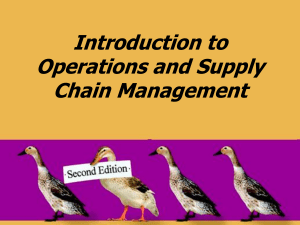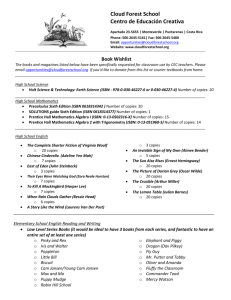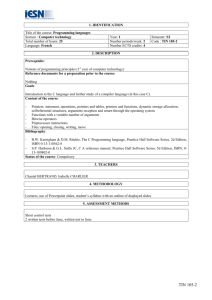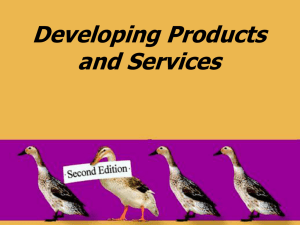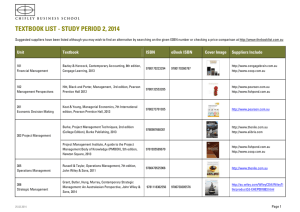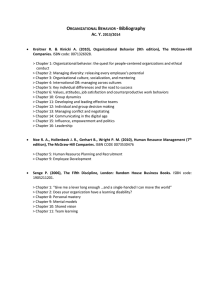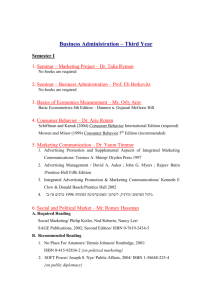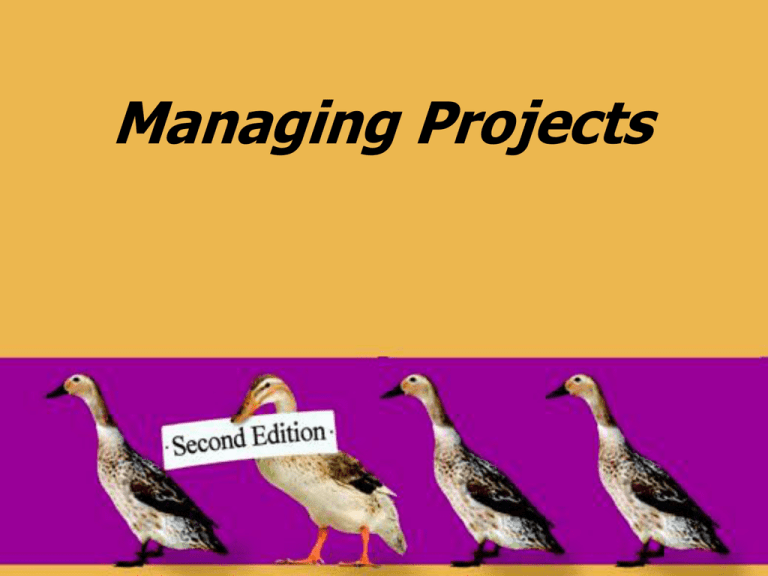
Managing Projects
Chapter Objectives
Be able to:
Explain the difference between routine business
activities and projects.
Describe the five major phases of a project.
Construct a Gantt chart and interpret the results.
Construct a project network diagram and
calculate the earliest and latest start and finish
times for all activities.
Identify the critical activities and paths in a
network.
Crash a project.
© 2008 Pearson Prentice Hall --- Introduction to Operations and Supply
Chain Management, 2/e --- Bozarth and Handfield, ISBN: 0131791036
Chapter 5, Slide 2
Project Management:
Why Do It?
Building Mega Refineries in Record
Time (India, 2006):
• Demand for gasoline is increasing in
USA
• No new refineries in USA
• Need to process heavy crude
• Current capacity is not enough
© 2008 Pearson Prentice Hall --- Introduction to Operations and Supply
Chain Management, 2/e --- Bozarth and Handfield, ISBN: 0131791036
Chapter 5, Slide 3
Reliance Industries, Ltd:
• Mobilized initial workforce of 20,000, will
grow to 150,000 to complete project by
December 2008
• Built residential complex for 2500 families to
attract skilled workers needed and an
irrigated 2000-acre farm nearby
• Expansion will add capacity of 582,000
barrels a day
• Each welder will have six helpers to keep him
supplied with necessary materials
© 2008 Pearson Prentice Hall --- Introduction to Operations and Supply
Chain Management, 2/e --- Bozarth and Handfield, ISBN: 0131791036
Chapter 5, Slide 4
What Is a Project?
A series of related tasks directed toward
some major output or goal
Often driven by a completion deadline
© 2008 Pearson Prentice Hall --- Introduction to Operations and Supply
Chain Management, 2/e --- Bozarth and Handfield, ISBN: 0131791036
Chapter 5, Slide 5
Project Phases I
• Concept Phase
– Broad definition and feasibility analysis
– Budget estimates within 30%
• Project definition Phase
– Tentative schedules, budgets, organization
– Budget estimates refined within 5% to 10%
© 2008 Pearson Prentice Hall --- Introduction to Operations and Supply
Chain Management, 2/e --- Bozarth and Handfield, ISBN: 0131791036
Chapter 5, Slide 6
Project Phases II
• Planning phase
– Detailed tasks, timing, budgets and resources
– Milestones
– Project management tools
• Performance phase
– Execution and control
• Postcompletion phase
– “Wrap-up”
– Reassignment of project resources
© 2008 Pearson Prentice Hall --- Introduction to Operations and Supply
Chain Management, 2/e --- Bozarth and Handfield, ISBN: 0131791036
Chapter 5, Slide 7
Statement of Work (SOW)
A written description of the project objectives
to be achieved, with
• a brief statement of the work to be done
• a proposed schedule specifying the start
and completion dates
• budget and completion steps (milestones)
• written reports to be supplied.
© 2008 Pearson Prentice Hall --- Introduction to Operations and Supply
Chain Management, 2/e --- Bozarth and Handfield, ISBN: 0131791036
Chapter 5, Slide 8
Breaking Down the Work
•
•
•
•
Allows independent operation
Improves manageability
Decentralizes authority
Enables monitoring and
measurement
• Provides assessment of required
resources
© 2008 Pearson Prentice Hall --- Introduction to Operations and Supply
Chain Management, 2/e --- Bozarth and Handfield, ISBN: 0131791036
Chapter 5, Slide 9
Work Breakdown Structure
(WBS)
Level
1 Program
2
Project
3
Task (group or organization)
4
Subtask
5
Work Assignment
(organizational unit)
© 2008 Pearson Prentice Hall --- Introduction to Operations and Supply
Chain Management, 2/e --- Bozarth and Handfield, ISBN: 0131791036
Chapter 5, Slide 10
Work Breakdown Structure
Example
Level
1 Custom Home Builder
2
Custom Home
3
Foundation (group or organization)
4
Concrete work
5
Set-up forms
(organizational unit)
© 2008 Pearson Prentice Hall --- Introduction to Operations and Supply
Chain Management, 2/e --- Bozarth and Handfield, ISBN: 0131791036
Chapter 5, Slide 11
Tools for Project Control:
Gantt Charts
ID Task Name
1
2
3
4
5
Activity 1
Activity 2
Activity 3
Activity 4
Activity 5
6 Activity 6
Start
4/4/2005
4/5/2005
4/7/2005
4/8/2005
4/13/2005
Finish
Duration
Apr 2005
4 5 6 7 8 9 10 11 12 13 14 15 16 17
4/6/2005
3d
4/8/2005
3d
4/11/2005 2d
4/15/2005 5d
4/14/2005 1d 4h
4/15/2005 4/18/2005
1d
...But there is no detailed information
about interrelationships
© 2008 Pearson Prentice Hall --- Introduction to Operations and Supply
Chain Management, 2/e --- Bozarth and Handfield, ISBN: 0131791036
Chapter 5, Slide 12
Tools for Project Control:
Network Diagrams
•
•
•
•
Network techniques
Consider precedence relationships
Capture interdependency of activities
Determine critical path(s)
– Sequence(s) of activities that determines
overall duration of the project
© 2008 Pearson Prentice Hall --- Introduction to Operations and Supply
Chain Management, 2/e --- Bozarth and Handfield, ISBN: 0131791036
Chapter 5, Slide 13
Critical Path Method (CPM)
Consider the following consulting project:
Activity
Designation
Immediate
Predecessor(s)
Duration
(weeks)
Assess customer’s needs
A
None
2
Write and submit proposal
B
A
1
Obtain approval
C
B
1
Develop service vision and goals
D
C
2
Train employees
E
C
4
Quality improvement pilot groups
F
D, E
5
Write assessment report
G
F
1
Develop a network diagram and determine the duration of the
critical path(s) and slack times for all activities
© 2008 Pearson Prentice Hall --- Introduction to Operations and Supply
Chain Management, 2/e --- Bozarth and Handfield, ISBN: 0131791036
Chapter 5, Slide 14
This activity-on-node (AON) diagram
shows the precedence relationships ...
D, 2
START
A, 2
B, 1
C, 1
F, 5
G, 1
FINISH
E, 4
. . .as well as the length of each activity.
Do you see the two paths through the network?
© 2008 Pearson Prentice Hall --- Introduction to Operations and Supply
Chain Management, 2/e --- Bozarth and Handfield, ISBN: 0131791036
Chapter 5, Slide 15
Some Definitions
• Earliest Start Time (ES)
= Latest EF for all immediate predecessors
• Earliest Finish Time (EF)
= ES + activity’s duration
• Latest Start Time (LS)
= LF – activity’s duration
• Latest Finish Time (LF)
= Earliest LS for all immediate successors
• Slack = amount of allowable delay in an
activity
= Equal to LS – ES or LF – EF for an activity
© 2008 Pearson Prentice Hall --- Introduction to Operations and Supply
Chain Management, 2/e --- Bozarth and Handfield, ISBN: 0131791036
Chapter 5, Slide 16
Insights
• A ‘hit’ to a critical activity will make project
late
• Rational time estimates needed
• Slack activities can start later
• Difference between effort-driven and timedriven activities
• Useful to have ‘Start’ and ‘Finish’ boxes on
network diagram, particularly when there
are two or more independent activities at
the beginning and/or end of a project.
© 2008 Pearson Prentice Hall --- Introduction to Operations and Supply
Chain Management, 2/e --- Bozarth and Handfield, ISBN: 0131791036
Chapter 5, Slide 17
Some Assumptions
• Project activities can be identified as
entities. (There is a clear beginning and
ending point for each activity.)
• Project activity sequence relationships
can be specified and networked
• Project control should focus on the
critical path (activities with no slack)
© 2008 Pearson Prentice Hall --- Introduction to Operations and Supply
Chain Management, 2/e --- Bozarth and Handfield, ISBN: 0131791036
Chapter 5, Slide 18
In First Example ...
• Network-based scheduling techniques to:
Show precedence
Determine project duration
Identify critical paths and activities
• Setting EF = LF for last activity implies
that current length of project is OK
© 2008 Pearson Prentice Hall --- Introduction to Operations and Supply
Chain Management, 2/e --- Bozarth and Handfield, ISBN: 0131791036
Chapter 5, Slide 19
However, there are often ...
• Deadlines for finishing projects
– (Olympic stadium, dormitories, etc.)
• Penalty or overhead costs if project
is late
• Competitive pressures
– Competitors, slowing demand
(Reliance Industries, Ltd.)
© 2008 Pearson Prentice Hall --- Introduction to Operations and Supply
Chain Management, 2/e --- Bozarth and Handfield, ISBN: 0131791036
Chapter 5, Slide 20
Ways to Shorten (Crash) a Project
• BORROW resources from noncritical activities (ones with greatest
slack)
• Add MORE resources
• Work MORE hours
• Spend MORE $$$$
© 2008 Pearson Prentice Hall --- Introduction to Operations and Supply
Chain Management, 2/e --- Bozarth and Handfield, ISBN: 0131791036
Chapter 5, Slide 21
Idea behind “CRASHING”
Duration of individual effortdriven activities can be
shortened, but at a cost
Example: Following project must be
completed by Week 26
© 2008 Pearson Prentice Hall --- Introduction to Operations and Supply
Chain Management, 2/e --- Bozarth and Handfield, ISBN: 0131791036
Chapter 5, Slide 22
Project Data
Activity
Duration
Predecessors
Crashable Weeks
A
6
None
None
B
11
A
4
$700
C
14
A
3
$2,000
D
2
A
None
E
4
B
1
$2,000
F
5
B
1
$1,000
G
6
C
1
$1,000
H
7
C
2
$2,000
I
3
D
None
J
4
E
None
K
4
F, G
2
$1,500
L
3
H, I
1
$2,500
© 2008 Pearson Prentice Hall --- Introduction to Operations and Supply
Chain Management, 2/e --- Bozarth and Handfield, ISBN: 0131791036
Crash Cost/Week
Chapter 5, Slide 23
Network Diagram for Project
E 17 21
E
L 22 26
6 17
L 10 21
S
S
E, 4
E 21 25
F
L 26 30
F
S
E 17 22
B, 11
L 21 26
F
E
0
6
L
0
6
E
6 20
E 26 30
S
F
L
6 20
L 26 30
S
START
S
F,5
F
J, 4
A, 6
F
S
C, 14
G, 6
F
FINISH
K, 4
E 20 26
E
0
0
L 20 26
E 30 30
L
0
0
S
L 30 30
S
F
F
S
H, 7
D, 2
E
6
8
L 22 24
S
F
F
E 20 27
L 20 27
S
L, 3
F
E 27 30
L 27 30
S
I, 3
E
F
8 11
L 24 27
S
F
© 2008 Pearson Prentice Hall --- Introduction to Operations and Supply
Chain Management, 2/e --- Bozarth and Handfield, ISBN: 0131791036
Chapter 5, Slide 24
1. Write Down All Possible Paths
and Lengths of Time for Each
Path
ABEJ
ABFK
ACGK
ACHL
ADIL
Length
25
26
30
30
14
© 2008 Pearson Prentice Hall --- Introduction to Operations and Supply
Chain Management, 2/e --- Bozarth and Handfield, ISBN: 0131791036
Chapter 5, Slide 25
2. Identify All Paths to be
Shortened
Path
ABEJ
ABFK
ACGK
ACHL
ADIL
Length
25
26
30
30
14
Critical Path
Critical Path
© 2008 Pearson Prentice Hall --- Introduction to Operations and Supply
Chain Management, 2/e --- Bozarth and Handfield, ISBN: 0131791036
Chapter 5, Slide 26
3. Find Lowest-Cost Way to
Shorten Critical Path(s)
Path
ABEJ
ABFK
ACGK
ACHL
ADIL
Length
25
26
30
30
14
To CRASH, either:
1. Shorten C or
2. Shorten {G or K} and
{H or L}
• Shorten C by 3 weeks
Cost = 3×$2,000 =
$6,000
© 2008 Pearson Prentice Hall --- Introduction to Operations and Supply
Chain Management, 2/e --- Bozarth and Handfield, ISBN: 0131791036
Chapter 5, Slide 27
Update Lengths in Table
Path
ABEJ
ABFK
ACGK
ACHL
ADIL
Length
25
26
3027
3027
14
Are we done?
What are our
next cheapest
alternatives?
© 2008 Pearson Prentice Hall --- Introduction to Operations and Supply
Chain Management, 2/e --- Bozarth and Handfield, ISBN: 0131791036
Chapter 5, Slide 28
To Crash Further
1. Shorten C some more, or
2. Shorten {G or K} and {H or L}
• Shorten Both G and H by 1 Week:
• Cost = $1,000 + $2,000 = $3,000
© 2008 Pearson Prentice Hall --- Introduction to Operations and Supply
Chain Management, 2/e --- Bozarth and Handfield, ISBN: 0131791036
Chapter 5, Slide 29
Update Lengths in Table
Path
ABEJ25
ABFK
ACGK
ACHL
ADIL
Length
26
302726
302726
14
Total Cost to Crash
= $6,000 + $3,000
= $9,000
© 2008 Pearson Prentice Hall --- Introduction to Operations and Supply
Chain Management, 2/e --- Bozarth and Handfield, ISBN: 0131791036
Chapter 5, Slide 30
If the reduction in overhead
per week is $4000
How many more weeks should the
company try to crash the
project?
Observations
• Cost of crashing becomes more and
more expensive as cheapest options
are used up
• There is a limit to how far a project can
be crashed.
• Crashing non-critical activities is
pointless
© 2008 Pearson Prentice Hall --- Introduction to Operations and Supply
Chain Management, 2/e --- Bozarth and Handfield, ISBN: 0131791036
Chapter 5, Slide 32
Controlling Projects
CPM used primarily to Plan and Schedule, BUT ...
• Things rarely go as planned
• The need for additional activities arises
• Better time and resource estimates are made as
project progresses use of PERT (Program
evaluation and review technique) where
probabilistic time estimates are used
© 2008 Pearson Prentice Hall --- Introduction to Operations and Supply
Chain Management, 2/e --- Bozarth and Handfield, ISBN: 0131791036
Chapter 5, Slide 33
Computer-Based Package
Advantages
• Regular updates
• Change analysis, tracking, and exception
reports
• High level of detail
• Scheduling around resource constraints
• Text examples using Microsoft Project™ on
pages 139-141
© 2008 Pearson Prentice Hall --- Introduction to Operations and Supply
Chain Management, 2/e --- Bozarth and Handfield, ISBN: 0131791036
Chapter 5, Slide 34
Project Management Institute (PMI)
www.pmi.org
• PMI:
– Sponsors education and certification
– Sponsors conferences, research, user groups
– Publishes Guide to the Project Management Body of
Knowledge (PMBOK®)
• PMBOK®
– Part I: Various business processes for projects
– Part II: Nine project knowledge areas
© 2008 Pearson Prentice Hall --- Introduction to Operations and Supply
Chain Management, 2/e --- Bozarth and Handfield, ISBN: 0131791036
Chapter 5, Slide 35
Managing Projects Case
Study
Viva Roma!

